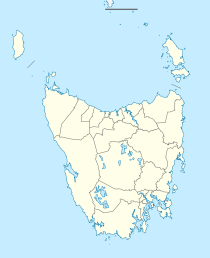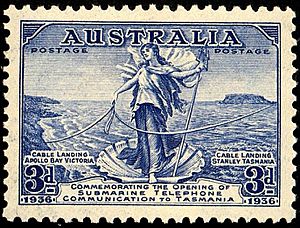Stanley, Tasmania facts for kids
Quick facts for kids StanleyTasmania |
|||||||||
|---|---|---|---|---|---|---|---|---|---|

Stanley and The Nut viewed from Highfield
|
|||||||||
| Population | 595 (2021 census) | ||||||||
| Postcode(s) | 7331 | ||||||||
| Elevation | 10 m (33 ft) | ||||||||
| Location |
|
||||||||
| LGA(s) | Circular Head Council | ||||||||
| State electorate(s) | Braddon | ||||||||
| Federal Division(s) | Braddon | ||||||||
|
|||||||||
Stanley is a small town located on the north-west coast of Tasmania, Australia. It is known for its beautiful coastal views and a unique natural landmark called The Nut. Stanley is part of the Circular Head area. In 2021, about 595 people lived in Stanley.
Contents
The History of Stanley: How It Began
In 1825, a company from England called the Van Diemen's Land Company received a large area of land in north-western Tasmania. This land included the area where Stanley is now. Workers from the company started to settle here in October 1826.
Why Is Stanley Called Stanley?
The place was first called Circular Head. Later, it was named after Lord Stanley. He was a British government official in charge of colonies in the 1830s and 1840s. Lord Stanley later became the British Prime Minister three times.
Early Life and Growth in Stanley
A port was opened in Stanley in 1827, which helped the town grow. The first school in Stanley opened in 1841, showing that more families were moving there. Stanley officially became a town in 1842. By 1843, many acres of land had been sold or rented to nearly 70 people.
The Post Office in Stanley opened on July 1, 1845. It was known as the Circular Head post office until 1882. In 1880, the first coach service started, connecting Stanley to Burnie. This made travel and trade easier.
Connecting Tasmania to the Mainland
In 1936, a special underwater telephone cable was laid. It connected Apollo Bay in Victoria to Stanley. This was a big step, as it provided the first telephone connection between Tasmania and mainland Australia.
Stanley Today: A Popular Tourist Spot
Today, Stanley is a popular place for tourists to visit. It is also the main fishing port on the north-west coast of Tasmania. Many people come to enjoy the town's history and natural beauty.
Exploring The Nut: Stanley's Famous Landmark
The most famous landmark in Stanley is Munatrik, usually called The Nut. It is an ancient, extinct volcano. Explorers Bass and Flinders saw it in 1798. They were sailing around Tasmania (then called Van Diemen's Land) and named it Circular Head.
The Nut has very steep sides and a flat top. It rises 143 metres high. You can walk to the top of The Nut using a steep path. There is also a chairlift that can take you up, which is a fun way to see the views.
What Else Can You See in Stanley?
Many tourists visit Highfield. This was the original home of the Van Diemen's Land Company. From Highfield, you can see beautiful northern beaches. The Nut stands tall in the background, making for amazing photos. The port on the southern side of The Nut is also a popular spot for fishing.
Important People Connected to Stanley
Many interesting people have lived in or been connected to Stanley:
- John Lee Archer – He was known as the "Father of Tasmanian architecture." He worked as a judge in the Circular Head area from 1838 until he passed away in 1852.
- Henry Hellyer – A chief surveyor, explorer, and architect who helped map the region.
- Enid Lyons – She was married to Joseph Lyons. Enid Lyons was a politician and made history as the first woman elected to the Australian Parliament. She was also the first woman to serve in the Cabinet of Australia.
- Joseph Lyons – He was the tenth Prime Minister of Australia.
- Bill Mollison – He started the permaculture movement, which is about creating sustainable ways of living and farming.
- Jim Willis – An Australian botanist who studied plants.
Stanley's Climate: Weather and Seasons
Stanley has an oceanic climate, which means it has mild temperatures all year round. It is also quite close to a warm-summer mediterranean climate. This means it gets more rain in summer than a typical Mediterranean climate. The total rainfall in Stanley is usually more than 900 mm each year.
Stanley's location by the sea helps keep its summers mild. The winters are rainy but not too cold. The highest temperature ever recorded in Stanley was 32.8 °C (91.0 °F) on March 14, 1967. The lowest temperature was −2.1 °C (28.2 °F) on August 7, 1963.
| Climate data for Stanley Post Office (10 m AMSL; BOM 1868-1999) | |||||||||||||
|---|---|---|---|---|---|---|---|---|---|---|---|---|---|
| Month | Jan | Feb | Mar | Apr | May | Jun | Jul | Aug | Sep | Oct | Nov | Dec | Year |
| Record high °C (°F) | 30.1 (86.2) |
29.9 (85.8) |
32.8 (91.0) |
25.0 (77.0) |
20.5 (68.9) |
18.7 (65.7) |
18.9 (66.0) |
16.6 (61.9) |
19.3 (66.7) |
21.1 (70.0) |
26.1 (79.0) |
28.5 (83.3) |
32.8 (91.0) |
| Mean daily maximum °C (°F) | 21.2 (70.2) |
21.5 (70.7) |
20.0 (68.0) |
17.4 (63.3) |
15.1 (59.2) |
13.3 (55.9) |
12.6 (54.7) |
13.2 (55.8) |
14.2 (57.6) |
16.0 (60.8) |
17.7 (63.9) |
19.4 (66.9) |
16.8 (62.2) |
| Daily mean °C (°F) | 16.7 (62.1) |
17.2 (63.0) |
15.9 (60.6) |
13.8 (56.8) |
11.9 (53.4) |
10.3 (50.5) |
9.6 (49.3) |
9.9 (49.8) |
10.8 (51.4) |
12.2 (54.0) |
13.7 (56.7) |
15.2 (59.4) |
13.1 (55.6) |
| Mean daily minimum °C (°F) | 12.2 (54.0) |
12.9 (55.2) |
11.8 (53.2) |
10.1 (50.2) |
8.7 (47.7) |
7.2 (45.0) |
6.5 (43.7) |
6.6 (43.9) |
7.4 (45.3) |
8.3 (46.9) |
9.6 (49.3) |
11.0 (51.8) |
9.4 (48.9) |
| Record low °C (°F) | 4.1 (39.4) |
5.0 (41.0) |
2.7 (36.9) |
0.7 (33.3) |
0.4 (32.7) |
−1.8 (28.8) |
−0.8 (30.6) |
−2.1 (28.2) |
−1.1 (30.0) |
−0.7 (30.7) |
2.7 (36.9) |
3.2 (37.8) |
−2.1 (28.2) |
| Average rainfall mm (inches) | 42.5 (1.67) |
46.9 (1.85) |
50.1 (1.97) |
76.1 (3.00) |
92.1 (3.63) |
104.4 (4.11) |
117.1 (4.61) |
103.9 (4.09) |
85.9 (3.38) |
86.2 (3.39) |
65.4 (2.57) |
62.0 (2.44) |
935.9 (36.85) |
| Average precipitation days (≥ 0.2 mm) | 10.1 | 9.6 | 12.5 | 15.4 | 18.8 | 18.9 | 21.7 | 20.9 | 18.2 | 16.7 | 14.6 | 12.7 | 190.1 |
| Average rainy days (≥ 1 mm) | 4.8 | 4.6 | 5.5 | 7.1 | 9.1 | 9.7 | 11.3 | 11.2 | 9.4 | 8.5 | 7.2 | 6.2 | 94.6 |
| Average afternoon relative humidity (%) | 64 | 66 | 69 | 73 | 76 | 78 | 78 | 76 | 74 | 71 | 69 | 67 | 72 |
| Average dew point °C (°F) | 12.7 (54.9) |
12.7 (54.9) |
11.8 (53.2) |
10.8 (51.4) |
9.6 (49.3) |
8.6 (47.5) |
7.5 (45.5) |
7.5 (45.5) |
8.1 (46.6) |
8.7 (47.7) |
9.8 (49.6) |
11.6 (52.9) |
10.0 (49.9) |
| Source: Bureau of Meteorology | |||||||||||||




